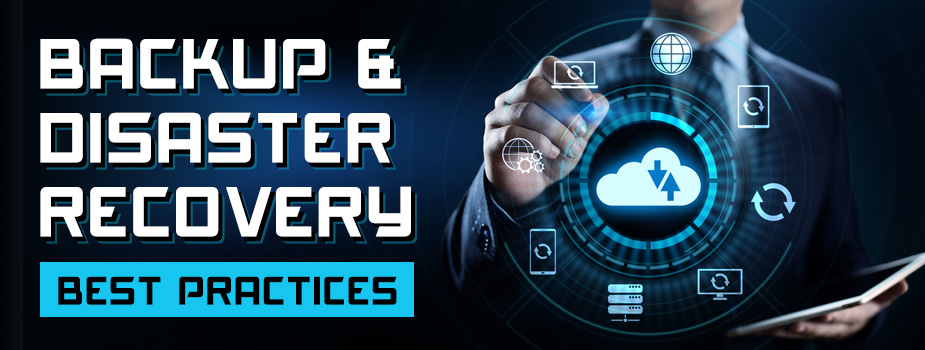Backup & Disaster Recovery Best Practices
Posted by Ben Marquis on Mar 24, 2020

3/24/2020
Backup, Replication, and Disaster Recovery (DR) have drastically changed, but the fundamental best practices remain the same.
Best Practices:
- Establish a Disaster Recovery Plan (DRP) with the following: backup schedule and start time & target finish time (backup window). Decide if you will run a weekly full, daily incremental or etc. backup. Determine Recovery Time Objective (RTO is the maximum tolerable length of time that a computer, system, network, or application can be down after a failure or disaster occurs.) with management. Determine a Recovery Point Objective (RPO is the age of files that must be recovered from backup storage for normal operations to resume if a computer, system, or network goes down as a result of a hardware, application, or communications failure. The RPO is expressed backward in time (that is, into the past) from the instant at which the failure occurs, and can be specified in seconds, minutes, hours, or days).
- Get a good backup and recovery application. If you are virtualized, make sure your backup application works with your specific hypervisor and server hardware. If you are not virtualized make sure the chosen application can handle those physical servers and any software applications you are using.
- Application awareness is important if you run software, such as a database, so that the backup software can quiesce those specific applications.
- If possible, do a local backup to a server, tape, VTL, or backup appliance. This will make restoration faster! If you choose to back up to the cloud, be sure to consider bandwidth to make sure you can meet backup windows and RTO. Consider SD-WAN if you are faced with looking at a new WAN connection.
- Establish a backup schedule and retention policy for backups based on your recovery point objective, recovery time objective, and any regulations you are subject to.
- A common scheme for retention and media rotation has always been Grandfather-father-son-backup. In this scheme daily, weekly, and monthly are rotated on that basis using a First in First Out (FIFO). If backing up to disk, you can set retention policies to emulate this practice.
- Get 1 copy of the data out of your primary production datacenter: cloud, tape copy offsite, etc. If you choose to backup to cloud, make sure this is done via your backup application and not file or virtual machine replication. Most popular applications like Avamar, Veeam, and others can automate this practice.
- If you replicate data to another site such as a ROBO or Colocation Facility you still need to adhere to step 2. If you run continuous replication, and data gets corrupted or compromised by ransomware, that does you no good and can simply spread the infection!
- Do full backups once a week and incremental backups daily. If RPOs are more aggressive, then adding more frequent snapshots to your daily backups may be appropriate. Remember snapshots are not backups.
- Do regularly scheduled testing to make sure you can restore from your backups!
- Consider an airgap for your backups. (Covered more in upcoming blog post)
Beyond the fundamentals, here are some considerations for modern problems:
- If you backup to a NAS or a file server via CIFS, NFS, SMB, etc., keep in mind that your backup data is still susceptible to malware/ransomware if persistently connected.
- If you get hit by ransomware, will you simply pay and keep your fingers crossed? What if you get hit with a true cyber event? Will you be able to restore your entire environment?
- Do you have a list of critical rebuild materials and backups of this info to speed recovery from a cyber event? The indexes and libraries in your backup application determine where data belongs. Could you manually rebuild without those? How long would that take?
- Make a list and prioritize which critical servers/VMs need to come online first!
- Are you required to encrypt your backups for regulatory compliance?
- What is your recovery point objective? What is your recovery time objective? What is your backup window like?
- If backing up to cloud, are you looking for BUaaS or DRaaS, these two are not the same, but often assumptions are made that are incorrect. If you wish to be able to spin up workloads in the cloud you are looking for DR in the cloud. Is your cloud provider consistent with your on-prem hypervisor? Consider data in and data out cost as well as the process of conversion, for example from AWS EC2 to VMware vSphere.
- Are you backing up Office365 accounts, GSuite, etc.? Contrary to popular assumption, Microsoft and Google are NOT backing up these accounts. They are in a single point of presence in most cases and must be backed up! Top backup applications can grab that data and back it up for you.
If you want to find out more about Dell’s solutions to these problems, you can give xByte a call (888-929-8348) and check out our recent blog post Dell EMC Data Protection Solutions”.
Everyone needs a good backup plan and xByte is here to help!
